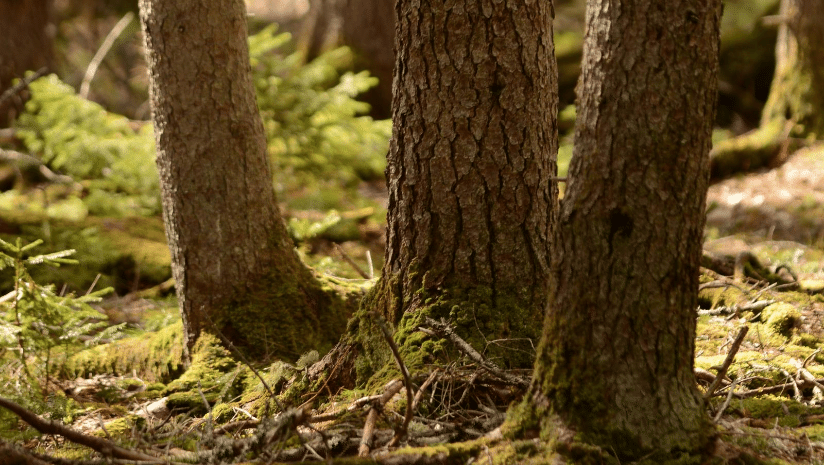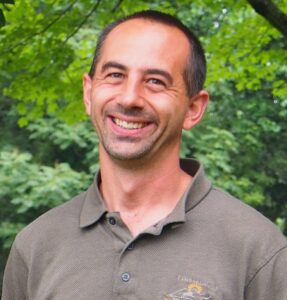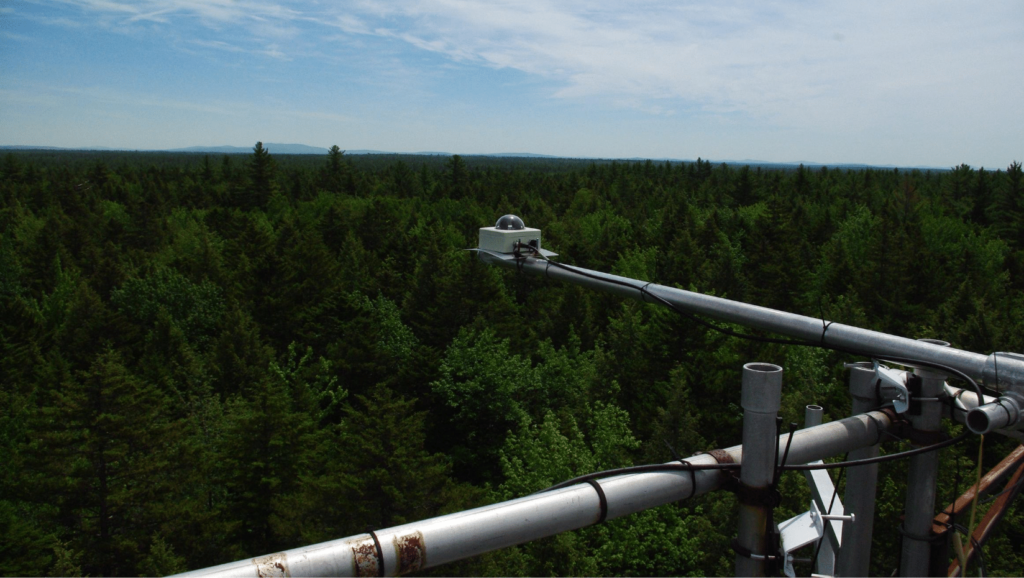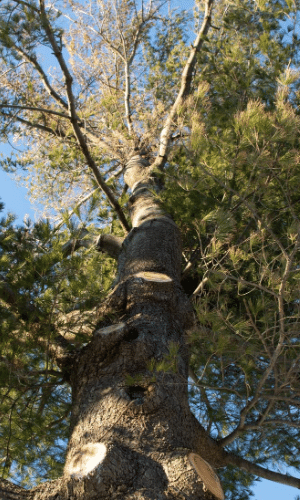
Maine’s Acadian Forest: The potential frontline of climate change in the age of vulnerability and big data
By Stefania Irene Marthakis
 IN THE NORTHERN REGION OF MAINE LIES THE SOUTHERN EXTENT OF BOREAL FORESTS, which are slower growing because of longer winters. Picture softwood or conifer trees (e.g., spruce, fir). As you head south, a more temperate climate is found with faster growing hardwoods like maple, oak, and birch. These two types of forests intersect in central Maine, where the University of Maine is located.
IN THE NORTHERN REGION OF MAINE LIES THE SOUTHERN EXTENT OF BOREAL FORESTS, which are slower growing because of longer winters. Picture softwood or conifer trees (e.g., spruce, fir). As you head south, a more temperate climate is found with faster growing hardwoods like maple, oak, and birch. These two types of forests intersect in central Maine, where the University of Maine is located.
In this transitional zone, Aaron Weiskittel, Professor of Forest Biometrics and Modeling and the Irving Chair of Forest Ecosystems Management at the University of Maine, heads the INSPIRES project, which officially began in August of 2019.
Leveraging Intelligent Informatics and Smart Data for Improved Understanding of Northern Forest Ecosystem Resiliency (INSPIRES) is possible through a four-year, $6 million (RII Track-2 FEC) grant from the National Science Foundation (NSF). Weiskittel, who is also the director of NSF’s Center for Advanced Forestry Systems and UMaine’s Center for Research on Sustainable Forests, is hoping to answer a critical question: “How do New England’s diverse and working forests respond to emerging and novel future stressors like changing winters, invasive pests, and greater seasonal variability?”
Working with nearly 28 million acres of forests across three states (Vermont, New Hampshire, and mostly Maine), Weiskittel and his team (Co-PIs: Kate Beard & Ali Abedi, UMaine; Scott Ollinger, UNH; and Anthony D’Amato, UVM) aim to develop comprehensive monitoring and harness the big data revolution. The INSPIRES project focuses on three areas: developing ecological sensors, working with K-12 educators (like those in highly forested rural Maine), and leveraging new technology, statistical methods, and computer science with an everchanging and highly dynamic ecosystem like forests. The forest is one of Maine’s most important economic resources.
The forest industry directly adds ~5% to the state’s GDP; one of the highest contributions of any state in the U.S. With the addition of tourism and hunting, Maine quickly becomes one of the most forest-reliant states. In addition, many Mainers view the forest as a vital piece of their heritage. However, the forest, inherently dynamic and visible, poses many challenges for modern foresters.

Forestry, itself, is in a state of transition due to expanding global markets, changing workforce development, ongoing mill closures, past/pending pest outbreaks (e.g., spruce budworm), technological advancements, and a younger generation of foresters. Maine may be well positioned as the new generation becomes interested in the forest, green collar jobs, and an emerging carbon economy. Governor Janet Mills has proposed that the state of Maine will be carbon neutral by 2045. This positions Maine as a potential leader in this industry, sustaining the heritage of its citizens within a future circular economy reliant on the sustainable management of extensive, yet dynamic natural resources.
INSPIRES proposes to address these multidimensional challenges by balancing Maine’s most important resources, landowners, workforce, and heritage on the frontlines of climate change. Researchers will use advanced technologies like wireless sensors and remote sensing to better monitor the forest, while researchers back in the lab develop new methods to handle this big data. In other words, the former provides the necessary data and the latter turns this data into readable information through interpretation and identifying key cycles that can help improve the ecological models used to forecast future conditions.
“Sensors are often hardwired to take data at regular and fixed intervals,” said Weiskittel. “Can we develop smarter technology that learns from itself and tells the sensor when to collect data at ecologically important intervals?”
To help answer this question, Sonia Naderi, Ph.D. candidate, is leading a team of two undergraduate students in the Electrical and Computer Engineering department, Victoria Nicholas and Thayer Whitney, to build a low-cost and low-power sensor suite.
“These low-cost sensors enable large scale deployment, providing much needed data points in places that no data has been collected in the past,” said Co-PI Ali Abedi.
The data collected by these sensors are then processed using artificial intelligence and machine learning methods developed by researcher Kenneth Bundy. With new areas of machine learning to explore, Bundy’s objective is to find optimum operating patterns that make sure the wireless sensors scattered throughout the forest are measuring parameters such as soil moisture, pH, and carbon in a way that allows them to effectively communicate with one another, and efficiently send information to a base station that allows remote online access to the data.
“Machine learning methods developed in this project not only process data, but also provide us new data on quality of wireless communication channels helping the researchers to design a network that can last a long time in the forest without the need for daily change of batteries,” said Abedi.

INSPIRES then goes a step further with ecological modeling, forecasting, and projecting a future forest under alternative scenarios. With so many different types of data, it is essential to come up with a common platform to understand key metrics. Weiskittel and his team have been working on these metrics within a broader vision akin to a real-time dashboard for the forest with a prototype version released in spring 2020: https://forestapp.acg.maine.edu/.
But what would a Digital Forest look like? Weiskittel describes his vision as an online interface (or “Digital Forest Big Data” framework) that anyone can log in to. This application would look and behave similarly to Google Earth, but the information would pertain specifically to Maine’s forested regions, which take up approximately 90% of the state’s entire land area.
With Weiskittel and his team spending a lot of time looking at vulnerability, one of the uses of this future forest app would allow a landowner to zoom in on a specific location in order to monitor spruce budworm defoliation or vulnerability. Landowners and researchers could also monitor for Canadian lynx or carbon. Thanks to the application, new possibilities for identifying “hot spots” of vulnerability may arise. Through spatial and ground data, the landowner would also be able to see a forty-year history of Maine’s forest, look at drivers, balance trade-offs, and address emerging trends.
 The INSPIRES project also aims to extend its reach with an educational component. The goal is to develop better curriculum materials and course content for middle school and high school students that teach how to interpret graphs, take measurements, and build other skills such as quantitative reasoning.
The INSPIRES project also aims to extend its reach with an educational component. The goal is to develop better curriculum materials and course content for middle school and high school students that teach how to interpret graphs, take measurements, and build other skills such as quantitative reasoning.
Along with education comes sustainability and legacy. To continue the work of INSPIRES, a Complex Systems Research Consortium will be developed. Through this institute, the University of Maine, the University of New Hampshire, and the University of Vermont will exchange information, leverage prior knowledge, and create a common framework to apply to difficult issues, particularly for natural ecosystems.
The University of Maine has a long history of bringing various people from different fields of research together to face issues that are relevant to Maine and beyond. With Governor Mills’ statement of carbon neutrality, INSPIRES plans to help achieve this goal by changing forest management and developing new relevant technology to help managers.
“That’s what excites me—bringing people together to work on something that can help the entire state,” Weiskittel said. “Moving this forward is critical, given the importance of our region’s forests. It’s particularly important that we do so with the goal of a low-carbon economy.”
